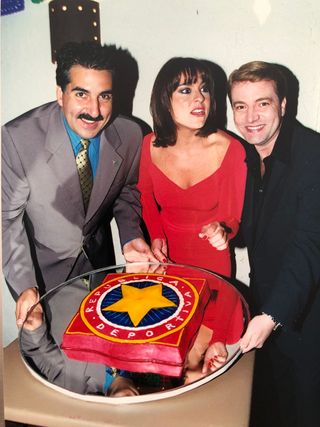Univision’s Republic of Sports

On Oct. 30, B&C and Multichannel News will sponsor the 17th annual Hispanic Television Summit, offering insights on the fastest-growing and most profitable audience for today’s television production, program distribution, promotion and advertising industries. The following are profiles of the people, programs and companies to be honored as award winners at the event at the Westin Times Square in New York. For more on the Summit and related NYC Television Week events, go to nyctelevisionweek.com.
More than 20 years after Univision’s popular República Deportiva Sunday sports show first bowed on television in April of 1999, one of its original hosts, Fernando Fiore, says he is still regularly stopped on the street by people shouting his nickname on the show, “El Presidente.”
“Wherever I go, they still call me El Presidente, even though I haven’t been on the show for years,” he said with a fond laugh. “The show has incredibly loyal fans. They still come up and talk about the show.”
Such stories testify to República Deportiva’s enduring appeal. “It is now the longest-running sports show on television in the U.S. in any language, Spanish or English,” said Federico Lariño, senior VP of sports entertainment at Univision Communications, who has overseen the program since 2014.
But the show’s popularity also highlights the creativity of its producers and its pioneering format, which helped earn it the Award for Outstanding Achievement in Hispanic Television and Video Programming at the Hispanic Television Summit.
“República Deportiva resonates with fans because the team behind it understands that being a sports fan is supposed to be fun,” said Eric Conrad, executive vice president of sports programming and acquisitions at Univision.
“What we were doing was something completely new for the Spanish market,” Fiore added. “No one at the time had done a show with a mix of sports and entertainment. It was a great sports show with all the elements of an entertainment show, a game show and variety. We traveled all over the world and interviewed big-time guests. Who could ask for anything more?”
Broadcasting & Cable Newsletter
The smarter way to stay on top of broadcasting and cable industry. Sign up below
It also broke the mold of the traditional sports show by featuring a woman, Rosana Franco, as one of its three original hosts, along with Fiore and Jorge Gomez. “She was great and really brought a lot of energy on camera to the show,” said Félix Fernández, who has been a co-host on República Deportiva since 2004.
“República Deportiva was the vision of our programming director at the time, Mario Rodrigues,” Fiore said. “He looked into the future and realized that the future was sports entertainment, which was a conjunction of words that was not much used in the 1990s. Many of my colleagues at time were very straightforward, treating sports like it was hard news.”
Crazy But Successful
Unlike typical sports shows hosted by journalists, Univision hired Fiore, who was an actor and host of a popular travel show — Fuera de Serie, alongside future Modern Family star Sofía Vergara — and created a set that looked more like a sports bar than a serious news set. After deciding to call the show República Deportiva, or Sports Republic, they decided the republic needed a president for some of the promos, which earned Fiore his nickname, El Presidente.
Early on the production team, led by executive producer Luis Blanco, added the Senadoras, scantily-clad presenters who conducted some interviews, as well as high-profile guests from the sports world and competitions. Initial reviews were mixed. “Many people in the industry, especially Spanish-language critics, said we would never last more than a month,” Fiore said.
Or even get on the air. Fiore and Blanco finished productio-n on his travel show in February and had only a month and a half to prep for the April 1999 launch of República Deportiva, which launched as a one-hour show.
“It was crazy, but it worked, and soon the show was so successful that we were expanded to two hours,” Fiore said.
The frenetic energy and innovation that helped get the show on the air carried over into the kind of exciting, live television that fans craved. Longtime host Félix Fernández recalled one show in 2009 that began airing before a game at what is now MetLife Stadium in East Rutherford, New Jersey. “People saw that we were on the air and many fans began coming to the stadium,” he said. “By the middle of the show, there were so many people it was really crazy.”
Over time, much has changed, with new hosts, new sets, new content and integrations with social media. The old set, replicating friends hanging out in a sports bar, is long gone. Its most recent set, which debuted in August, features a modern look full of LED displays and screens, Lariño noted.
The show, which originally aired just on broadcast network Univision, now gets wider distribution with a simulcast on TUDN, the former Univision Deportes, in the U.S. and Mexico.
Social-media posts were added to the mix. “In the highlights, we will show the best plays and a goal and then we’ll put in a Twitter message, a video from YouTube from a fan at the stadium and maybe a comment from one of the coaches or players from Instagram after the game,” Lariño said. “So when you watch the highlights of a game, you get the best plays and the goals along with what happened on social media.”
In many ways, the more things have changed, the more they have remained the same. “It is not like we added things just because we wanted to modernize things,” Lariño said. “The list of producers, hosts and staff has all changed over the year. But it’s still a family-oriented show. We are still working to produce the same feeling — the fun and lighthearted way of approaching sports that fans have always loved.”
